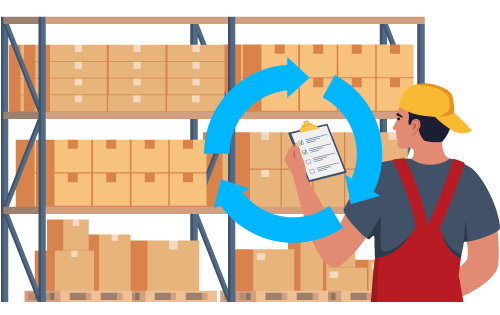How Can We Consolidate Orders?
Built For


- The significance of order consolidation
- Strategies for implementation
- Best practices to consolidate orders
- Ways to overcome challenges
How Can We Consolidate Orders?
Managing orders from multiple channels can be daunting in today’s fast-paced business landscape, where e-commerce and omnichannel strategies reign supreme. Whether products are sold via online marketplaces, a direct sales team, or through an eCommerce site, customers expect a seamless shopping experience across all touchpoints. However, behind the scenes, businesses grapple with consolidating orders efficiently to streamline inventory management and order processing.
Order consolidation, the process of aggregating orders from various sales channels into a unified system, is critical for modern business operations. It facilitates smoother inventory management and enhances order fulfillment and customer satisfaction.
In this article, we delve into the intricacies of order consolidation, exploring its significance, strategies for implementation, best practices, and ways to overcome common challenges. So, buckle up as we embark on a journey to uncover the secrets of effective order consolidation in today’s dynamic business environment.
Understanding Order Consolidation
Order consolidation might sound like a fancy term, but at its core, it’s all about simplifying the chaos of managing orders from different places. Picture this: You’re running a small business selling various products. Your customers are scattered across multiple platforms, like your website and marketplaces, sometimes they call with orders, and you are considering implementing EDI to sell to big-box retailers.
Now, each time someone places an order, it’s like a tiny jigsaw puzzle piece landing in your lap. But instead of fitting neatly together, these pieces often end up scattered across the room. That’s where order consolidation swoops in, gathering up all those pieces and slotting them snugly into place.
So, what exactly does order consolidation involve? Well, it’s about bringing all those scattered orders from different channels – your website, the direct sales team, marketplaces, and even EDI – and bundling them together into one tidy package. Think of it as corralling a herd of unruly cats into a single file line.
Why bother with all this fuss? Without order consolidation, you’re juggling multiple systems, drowning in a sea of spreadsheets, and risking costly mistakes like overselling or shipping delays. Plus, your customers expect nothing less than lightning-fast service, and manual order management won’t cut it in today’s hyper-competitive market.
Strategies for Consolidating Orders

Now that we have a handle on what order consolidation is about let’s dive into some strategies to make it happen. Remember, the goal here is to turn chaos into harmony – to transform a jumbled mess of orders from various channels into a well-oiled machine that keeps your business humming.
A Centralized Inventory and Order Management System (OMS)
Imagine having a command center where all your orders converge – that’s what a centralized OMS is all about. It’s like the control panel of a spaceship, allowing you to see all your orders in one place, no matter where they came from.
With a centralized OMS, you can say goodbye to hopping between different platforms to check for new orders. Everything you need, from order details to customer information, is at your fingertips.
Integration of Sales Channels
One key to successful order consolidation is seamless integration between your various sales channels. It’s like connecting the dots—each channel feeds into the central hub of your OMS.
Whether it’s your website, third-party marketplaces, or EDI, integrating all sales channels with your OMS ensures that every order flows smoothly into the system without a hitch.
Workflow Optimization
Let’s face it – manually processing orders is a recipe for disaster. That’s where automation comes in, taking care of repetitive tasks so you can focus on the big picture.
From order processing to inventory updates, automation streamlines the entire order process, reducing errors and speeding up fulfillment times. By implementing these strategies, businesses can consolidate orders efficiently, paving the way for smoother inventory management and faster order processing.
Best Practices for Efficient Order Consolidation
Now that we’ve explored strategies for consolidating orders, it’s time to discuss some best practices to ensure that your order consolidation efforts are effective and downright stellar. These practices are like the secret sauce that takes your order consolidation game from good to great, ensuring smooth sailing even in the choppiest waters.

Inventory Sync Across Channels
Imagine: A customer orders via the direct sales team, and the inventory levels on your eCommerce site are updated. That’s the power of an inventory sync. By keeping inventory levels across all channels up-to-date, you avoid the nightmare of overselling and stockouts, keeping you and your customers happy.
Monitoring and Reporting
In the world of order consolidation, knowledge is power. That’s why it’s crucial to monitor the entire process, from order intake to fulfillment.
By monitoring key metrics like order volume, processing times, and inventory levels, you can identify bottlenecks and inefficiencies before they spiral out of control. Plus, detailed reporting provides valuable insights for future optimization efforts.
How Can We Consolidate Orders? FAQs
How can we consolidate orders?
Order consolidation is the process of aggregating orders from various sales channels into a centralized system for streamlined inventory management and order processing. Order consolidation is essential for businesses because it helps avoid the chaos of managing orders from multiple sources separately, leading to improved efficiency, accuracy, and customer satisfaction.
How does order consolidation differ from traditional order management?
Traditional order management typically involves managing orders from a single channel or platform using standalone systems or spreadsheets. In contrast, order consolidation involves integrating orders from multiple channels (e.g., eCommerce websites, EDI, marketplaces, direct sales) into a centralized inventory and order processing system, allowing businesses to manage all orders from a single platform.
What are some key benefits of using a centralized order management system for consolidation?
- Streamlined order processing: All orders from different channels are managed from a single interface, reducing the need for manual intervention and streamlining the order fulfillment process.
- Improved inventory management: Centralized inventory and order management systems provide visibility into inventory levels across all channels in real time, reducing the risk of overselling and stockouts.
- Enhanced customer satisfaction: By consolidating orders efficiently, businesses can fulfill orders more accurately and faster, improving customer satisfaction and loyalty.
Call us at 817-870-1311




